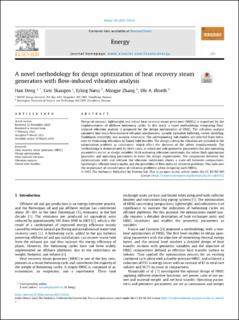A novel methodology for design optimization of heat recovery steam generators with flow-induced vibration analysis
| dc.contributor.author | Deng, Han | |
| dc.contributor.author | Skaugen, Geir | |
| dc.contributor.author | Næss, Erling | |
| dc.contributor.author | Zhang, Mingjie | |
| dc.contributor.author | Øiseth, Ole Andre | |
| dc.date.accessioned | 2021-04-30T13:26:34Z | |
| dc.date.available | 2021-04-30T13:26:34Z | |
| dc.date.created | 2021-04-12T08:49:14Z | |
| dc.date.issued | 2021 | |
| dc.identifier.issn | 0360-5442 | |
| dc.identifier.uri | https://hdl.handle.net/11250/2740658 | |
| dc.description.abstract | Design of compact, lightweight, and robust heat recovery steam generators (HRSGs) is important for the implementation of offshore bottoming cycles. In this work, a novel methodology integrating flow-induced vibration analysis is proposed for the design optimization of HRSG. The vibration analysis considers four main flow-induced vibration mechanisms, namely turbulent buffeting, vortex shedding, fluidelastic instability, and acoustic resonance. The corresponding sub-models are selected from literature for estimating vibrations of finned tube bundles. The design criteria for vibration are included in the optimization problem as constraints, which affect the decision of the solver simultaneously. The methodology is demonstrated by three cases, in which not only geometric parameters but also operating parameters are set as design variables. With activating vibration constraints, the solver finds appropriate geometric and operating parameters to meet the design requirements. The comparison between the optimizations with and without the vibration constraints shows a trade-off between compactness, lightweight, efficient heat transfer, and the possibility of flow-induced vibration problems. This indicates the importance of consideration of vibration problems when designing such HRSGs. © 2021 The Author(s) | en_US |
| dc.language.iso | eng | en_US |
| dc.publisher | Elsevier | en_US |
| dc.rights | Navngivelse 4.0 Internasjonal | * |
| dc.rights.uri | http://creativecommons.org/licenses/by/4.0/deed.no | * |
| dc.title | A novel methodology for design optimization of heat recovery steam generators with flow-induced vibration analysis | en_US |
| dc.type | Peer reviewed | en_US |
| dc.type | Journal article | en_US |
| dc.description.version | publishedVersion | en_US |
| dc.rights.holder | The Authors | en_US |
| dc.source.volume | 226 | en_US |
| dc.source.journal | Energy | en_US |
| dc.identifier.doi | 10.1016/j.energy.2021.120325 | |
| dc.identifier.cristin | 1903439 | |
| dc.relation.project | Norges forskningsråd: 280713 | en_US |
| dc.source.articlenumber | 120325 | en_US |
| cristin.ispublished | true | |
| cristin.fulltext | original | |
| cristin.qualitycode | 2 |
Tilhørende fil(er)
Denne innførselen finnes i følgende samling(er)
-
Publikasjoner fra CRIStin - SINTEF Energi [1640]
-
SINTEF Energi [1764]

